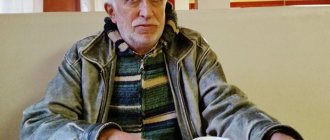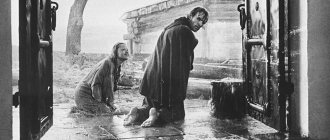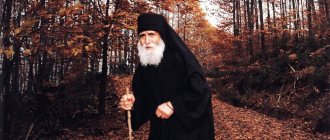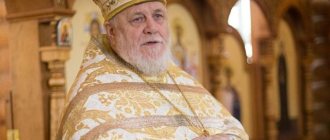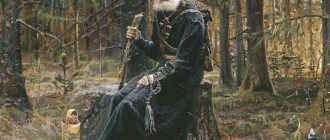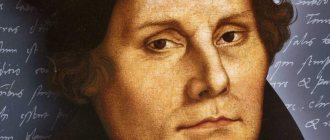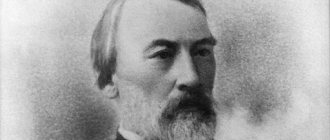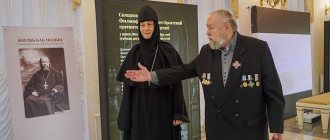The plot of the picture
Among the actors of the film “The Monk and the Demon” (2016) there are many notable and outstanding domestic masters. Viewers witness the events that take place in Russia in the 19th century. A mysterious and suspicious inhabitant named Ivan appears in a monastery and works miracles. The abbot is forced to restrain him, as he doubts the divine nature of his power.
In the end, it turns out that Ivan has been tempted all this time by a demon whose name is Legion. The main character exchanges his soul for a demon to take him to the Holy Land. The Legion transports Ivan by air to Jerusalem, despite the fact that demons are not supposed to be there, and they can hardly endure this terrain.
Ivan in Jerusalem begins to behave like Christ. He turns over trays of goods from local merchants who sell souvenirs under the guise of sacred relics, trying to drive them away exactly as the Savior did. But he is severely beaten. By paradoxical chance, only the devil saves him from death, using black magic.
Then, having bowed to the Holy Sepulcher, Ivan drags the demon along with him. He loses his incredible strength and almost dies. In Russia, they are mistaken for tramps and sent to prison, where the life of the main character ends. The legion comes to the very monastery where this whole story began to become one of the novices.
“The Monk and the Demon”: the hagiographic basis of the film
The film “The Monk and the Demon” became, perhaps, one of the most striking new releases in Russian cinema of the past year. During this time, the film managed to fall in love with a wide range of viewers, not only Orthodox Christians, and received several significant prizes and awards (“White Elephant”, “Golden Eagle”, Grand Prix of the “Pokrov” festival). Today she is already among the six contenders for the main national award - the Nika Award, the winners of which will be announced on March 28. In many ways, the success of “The Monk and the Demon” is based on an atypical problematic, an interesting idea of the film: is it possible to teach evil spirits good? It is interesting that director Nikolai Dostal was prompted to such thoughts by real stories from the lives of holy ascetics.
Unusual novice of the Nilo-Sora desert
Repeatedly in his interviews, Nikolai Dostal himself points out that the main impetus for the idea of creating the film was his acquaintance with the life story of Ivan Semenovich Shaposhnikov, a former inhabitant of the Nilo-Sora monastery. As we can see, the author of the picture even borrowed the name for his main character from him - Ivan, Semenov’s son. What is known about this wonderful holy fool ascetic?
Ivan was born in 1802 in the city of Galich, Kostroma province, into a family of burghers. It is known that he had a talent for icon painting and craftsmanship, which he did in his youth. However, at the age of eighteen, he had to give up this occupation dear to his heart: due to paralysis, his right arm and legs were affected, until the end of his life he could no longer use them freely, he moved only with the help of a stick. But even in this, the young man saw the clear providence and will of God and decided to leave this vain world, going to a monastery.
Ivan’s first refuge was the Kirillo-Novoezersky Monastery. Here, however, he did not stay long, since his illness did not allow him to carry out harsh labor obediences. Expelled from this monastery, the novice came to the Nilo-Sora Hermitage, located nearby, where he spent all his remaining years of asceticism. The abbot of the monastery, Hieroschemamonk Neil, quickly recognized in the young novice the wondrous chosen one of God, and they soon became spiritual associates.
"If you don't want to serve me, then go back to Kirill."
At first, however, Ivan greatly missed his first monastery. However, the Lord Himself consoled him and stopped this immeasurable sorrow through His saint, the Venerable Nile of Sorsky. Once, during a service in the temple, when Ivan’s thoughts were entirely in the Novozersky monastery, the Monk Neil himself unexpectedly came out of the altar and said: “If you don’t want to serve me, then go back to Cyril.” After this vision, the novice’s melancholy disappeared without a trace; he joyfully carried his exploits to the monastery all subsequent years.
Soon, novice Ivan Shaposhnikov, ascending from strength to strength, was able to acquire such necessary, but rare qualities even for monastics, as humility, absolute kindness and non-covetousness. Moreover, the gift of love inherent in him also extended to all of God’s creation. The brethren noticed that while being obedient in the refectory, he even fed cockroaches out of pity: crushing and soaking bread specifically for these purposes, Ivan Semenovich put them in those places where there were the most insects. He carried out his obedience in the refectory for twelve whole years, while the kitchen replaced his cell, and here he slept on the stove, covered with boards. The novice’s clothing was unchanged: at any time of the year he wore the same cassock, and usually did not wear shoes.
It is not surprising that the saint had to endure much ridicule and bullying from the younger brethren. He endured all this calmly, never got angry or offended, very often covering up his feat with foolishness.
Over time, still remaining in the ranks of novices, Ivan Semenovich was awarded some grace-filled gifts. For example, the gift of insight: often the invisible world was revealed to him. He knew which of the brethren were distracted by obscene thoughts during prayer, and he meekly rebuked them. The seer noticed that fire was coming from the mouths of the fervently praying monks. The saint also saw how the newly tonsured are usually followed by two angels. There is a known case when one day during a meal, Ivan Semyonovich laughed loudly when he saw how an angry monk who was inattentive to reading was saddled by a demon and rode him.
Just as a city standing on top of a mountain cannot hide, so the unusual seer soon became known throughout the area. People with their sorrows and illnesses began to come to Ivan Semenovich. He accepted them with love, but quickly became burdened by such worldly fame. With the blessing of the abbot, he built himself a remote cell in a swamp and there he continued to carry out his feat.
It is clear that the success of the wondrous old man could not be hidden not only from people, but even more so from the enemy of the human race. He tried in every possible way to turn him away from serving God, to confuse him. Even when Ivan Semyonovich was obedient in the refectory, demons repeatedly appeared to him in reality in their terrible form. The brethren often heard strange sounds coming from there, and the next morning they found the novice covered in bruises, barely alive. The demons lifted him above the ground and forced him to dance. However, the warrior of Christ did not succumb to them. Sometimes these attacks were so terrible that he asked one of the brethren to stay with him in the kitchen overnight.
When Ivan Semenovich moved to a remote cell, the demonic insurance and bullying only became more severe. One day, when he was returning to his place after the evening rule, a terrible Ethiopian attacked him in the forest with a club and beat him so much that the novice lay unconscious for a long time. The scar from the blow to the head remained with him for the rest of his life.
However, unexpected help and consolation in the struggle soon came. One evening, Archdeacon Stefan appeared to the elder in his cell and pointed to the copper cross, saying that with it he would defeat demons. Before this, Ivan Semenovich’s cross lay neglected, since it was eight-pointed, and the righteous man believed that the correct cross should only be four-pointed.
This was not the last wonderful visit of the ascetic. During a serious illness, he was also honored with the appearance of the Lady Herself, accompanied by the holy virgins: the Venerable Anastasia and the Great Martyr Catherine. From her own Most Pure hands, the Queen of Heaven gave the old man cabbage soup with black bread (his only dish), after tasting which he immediately recovered.
But the years of Ivan Semenovich’s earthly life were still coming to an end. He died on May 13, 1863. And only six years before his death he was tonsured into the ryassophore.
How the Archbishop of Novgorod saddled a demon
Another prototype of the main character of the film “The Monk and the Demon” was St. John of Novgorod. He was the first elected, and not appointed from Kyiv, as was the case before, Archbishop of Novgorod from 1165 to 1186. This saint should be well known to us from the history of the “Sign” icon of Novgorod, whose memory is solemnly celebrated on December 10.
It was to this archbishop that the Most Pure Mother of God appeared in response to prayers and commanded that Her icon be moved from the temple and installed on the walls of the city, which had been besieged by the Suzdalians for three days. Only through his prayers did the icon, now called “The Sign,” move from its place and allow itself to be transferred to the indicated place. It was this saint who was wiping away the tears of the Mother of God with his phelonion when the icon suddenly “cryed,” turning its face to the Novgorodians. As you know, after all these events, the Suzdal warriors, who were attacked by darkness, began to kill each other - the city was saved.
In addition to this event, a whole series of various traditions and legends are associated with the name of John of Novgorod, of which there are about 150 in total. The journey to Jerusalem on a demon is one of the most vivid and famous stories, included even in the life of the saint.
As we have already seen from the case of the “Sign” icon, Archbishop John was a great and bold man of prayer. Such prayer is pleasing to God, but it causes anger and annoyance in the demonic force. And so, during the saint’s next private prayer, one imp, wanting to distract the ascetic from his work, began splashing around in a vessel of water that served as a washbasin. The saint was distracted, but quickly understood the enemy’s trick. He crossed the vessel, thereby blocking the demon’s exit from there.
Burned by the power of the sign of the cross, the unclean man began to ask John to let him out of the laver. Then the archbishop replied that he would do this only if the demon took him to the Holy Land and back. The imp agreed and, taking the form of a horse, fulfilled his promise, taking the archbishop to Jerusalem and back in one night. There the saint was able to visit the Church of the Resurrection of Christ, the entrance to which was opened through his prayers, and venerate the Holy Sepulcher, as well as all other shrines.
The demon was put to shame. But for his “service” he asked John not to tell anyone about this journey, otherwise the evil one promised to take annoying revenge on him. However, one day, solely with edifying intentions, the righteous man nevertheless mentioned in a conversation that he knew a person who had traveled on a demon to Jerusalem.
“Instead of floating down the river, the raft floated up - against the current. Then people realized that they had been cruelly deceived by the evil one.”
Then the evil one began to take revenge on him, trying to slander him. He either left the saint’s cell, taking on the appearance of a harlot, or tossed him various items of women’s clothing there. People fell into the “trap” and wanted to get rid of the ruler, who, in their opinion, had disgraced himself with the sin of fornication. When they came to their master, a demon disguised as a girl was just running out of his cell.
This was the last straw that overflowed the cup of indignation. The people put their once beloved shepherd on a raft and sent him sailing along the Volkhov River. However, a miracle happened here, which made it possible to immediately “rehabilitate” the saint. Instead of floating down the river, the raft floated up - against the current. Then people realized that they had made a mistake and had been cruelly deceived by the evil one. They asked their ruler for forgiveness and begged him to return. The kindly shepherd, of course, did not hold a grudge and returned to the city. In memory of this event, a stone cross was erected by the Novgorodians at the place where the raft with the archbishop stopped.
It should be noted that the plot with a tamed demon from the life of John of Novgorod is quite popular, and this was not the first time it was used in the film “The Monk and the Demon.” Before this, the hagiographic narrative also received its artistic interpretation in Russian literature. Many must have immediately remembered the famous flight on the line behind the slippers from Gogol’s story “The Night Before Christmas”. It is noteworthy that the same hagiographic motif was also used by A.S. Pushkin for his first (unfinished and long considered lost) poem “The Monk”.
However, let's not confuse creative interpretation with simple borrowing. The story of Ivan, Semyonov’s son, and the demon named Legion is only a “reflection on the topic”, and not Orthodox teaching. As you know, good and evil live according to their own laws, and art - according to its own. Therefore, any accusations of heresy and “non-canonicality” in relation to the film “The Monk and the Demon” are unfounded and ridiculous.
You can applaud the author (at least 10 times)10
Timofey Tribuntsev
In the film “The Monk and the Demon” (2016), the actor playing the main role is Timofey Tribuntsev. This is the monk Ivan, who throughout the entire plot struggles with strong temptations.
This is a famous domestic actor who managed to make a name for himself not only in cinema, but also in the theater. He can be seen on the stage of the Satyricon Theater and many independent theater projects.
His film debut began with the TV series “Truckers.” The first role in a full-length film was a cameo appearance in Nikolai Lebedev’s war film “Star”. At the moment, he already has several dozen roles to his credit. He is considered one of the most sought-after actors in modern cinema.
In 2021, he received the Nika Award for Best Actor in the film “The Monk and the Demon” (2016). The actors and the roles they play fit together seamlessly. This was noted by the festival jury.
Actors and filming
The main role, as already mentioned, went to actor Timofey Tribuntsev . Although initially the director looked at a completely different actor for her. But circumstances so happened that he was unable to take part in the film. In addition, the filmmaker was looking for little-known actors.
Actor Tribuntsev had just left the cast of Satyricon at that time and was ready to move to another city and grow a beard for the sake of filming. The actor impressed everyone so much with his performance that in the film he plays two roles at once - a demon and a human. But how? It’s just that when a demon entered the plot, the actor played a person.
Actor Georgy Fetisov was invited to audition for the filming, which was very interesting. The director just saw him on the theater stage. He had a beard and mustache. Then Nikolai decided that this particular person should play the role of a demon in his film. And I was right. The little-known Fetisov wonderfully got used to the character and presented it to the viewer as colorfully as possible.
Georgy Fetisov
Among the actors in the film “The Monk and the Demon”, Georgy Fetisov must be highlighted. He received the image of a demon named Legion.
Fetisov himself is from Krasnoyarsk. He admits that he began dreaming about cinema at the age of three. He studied at the acting department of the International Slavic Institute named after Derzhavin. Permanent actor of the “School of Dramatic Art” theater.
He performed his first film role in 2010. It was the series “Capercaillie. Return". Working with Nikolai Dostal was his first serious role in a Russian feature film. Most recently, Fetisov starred in Vladimir Khotinenko’s historical-drama series “Demon of the Revolution,” getting into the character of Grigory Zinoviev.
Nikolay Dostal, director, from an interview with the IZVESTIA newspaper
“The Monk and the Demon” fits into the tradition of cinema that tells about miracles and passions, but it is a truly funny film. Opening up a religious theme with a comic twist is a way to bring it closer to the public?
— You need to talk about serious things with a smile and irony. Even in relation to such a complex and eternal topic as the fight against the demons sitting in each of us. And this struggle is permanent. “The Monk and the Demon” exists at the intersection of fairy tales, hagiographic and fantastic stories. But what I was striving for was tragicomedy.
— How did the collaboration develop with the performer of the role of the simple-minded foolish monk?
— Working with an actor begins with assigning him to the role. I believe that in this case I very successfully “figured out” Timofey Tribuntsev. He had previously acted in small roles for me, and I also saw him on stage at Raikin’s Satyricon Theater. The image of Ivan Semenovich corresponds to the internal architectonics of this artist.
For Georgy Fetisov, who previously played in the Anatoly Vasiliev Theater, the role of a demon named Legion was his first big role in cinema. And he coped with the tasks assigned. It was important for me that the viewer saw the unknown face of the tempter, and in no case a media person.
— This is not the first time you have filmed in Vologda. Are local spaces inspiring?
- Yes, I shot four films in the Vologda region - it turned out as if by the will of fate. These places captivated me in 1994, when I was looking for locations for “The Little Demon.” It was necessary to find a town where ancient wooden houses, streets, and churches were preserved. In Vologda we found all this.
When, years later, I started filming a film about Shalamov, God himself ordered me to come here, to the homeland of Varlam Tikhonovich. But Vologda itself was no longer suitable as a space in which pre-revolutionary events could unfold. We found the necessary landscapes in Veliky Ustyug, Vologda region, where we filmed the hero’s childhood and youth.
How was it possible not to film “Raskol” in Vologda places if Nikon was in exile here? The scenes with Avvakum and noblewoman Morozova were also brought in here. In the Kirillo-Belozersky Monastery, I chose location for filming “The Monk and the Demon.” In the Vologda region I not only work, but also relax - in Ferapontovo. Many of my Moscow friends, mostly artists, have houses there. And in general, the north of Russia is closer to my soul than the south.
Boris Kamorzin
In the film “The Monk and the Demon” (2016), actor Boris Kamorzin plays the abbot and abbot of the monastery. For his work, he, like Tribuntsev, received the Nika statuette, but for the best supporting actor. It is worth recognizing that the creators of the film managed to select a truly brilliant acting ensemble, albeit from little-known actors.
Kamorzin was born in Bryansk. He studied at the Shchukin Theater School. He worked in many capital theaters - the Moscow Theater for Young Spectators, the Vakhtangov Theater, and in a theater called the "Commonwealth of Taganka Actors."
He played his first film role with Nikolai Dostal in the famous 1990 tragicomedy “Cloud-Paradise”, playing comrade Saratov. Among his bright and notable works, it is also worth highlighting his participation in the tragicomedy by Valery Chikov “Should we send us a messenger?”, the action film by Yegor Konchalovsky “Antikiller”, the detective series by Sergei Ursulyak “Liquidation”, the multi-part comedy by Alexey Kiryushchenko “The Adventures of Soldier Ivan Chonkin”, road -movie by Sergei Loznitsa “My Happiness”.
Russia, 30s of the 19th century, reign of Nicholas I. A monk named Ivan Semyonov's son (Timofey Tribuntsev) comes to a small monastery located in the wilderness, from a burnt monastery in the Nilo-Sora wasteland. This monk is very strange: Ivan’s clothes periodically spontaneously burst into flames, but he behaves impudently, answers questions with offensive patter and, it seems, is not afraid of anyone.
The venerable abbot (Boris Kamorzin), the abbot of the monastery, senses something wrong in Ivan, some kind of devilry, but accepts him into the monastery and allocates him a cell.
To pacify the violent monk, the abbot comes up with all sorts of obediences for him: clean a long-overgrown well, catch fish for dinner. But even here, Ivan knows how to surprise: he cleaned the well in a couple of hours instead of a couple of weeks, and instead of ordinary fish he caught some kind of huge fish monster, which the entire monastery would not devour in a week.
Then the abbot took Ivan to a distant hut and forced him to wash and iron the monastery trousers.
Meanwhile, the monastery encountered a new misfortune: the Tsar-Sovereign Father Nicholas I himself, together with Benckendorff and his guards, asked the abbot for shelter - during the trip, the spring of the Tsar’s Agritsky carriage broke and he could not continue the journey.
The king was told about a strange monk who performed miracles, and he wanted to meet Ivan.
***
Several people recommended this film to me with the words “Finally, something worthy was filmed in Russia.” However, even if they weren’t recommended, I would still be going to watch it, because this film was directed by the wonderful director Nikolai Dostal, and the cast included a very bright actor Timofey Tribuntsev - for me, such films are from the “must watch” series.
I looked. Fortunately, hopes were justified - the film turned out to be very worthy: it is well made and has excellent acting, and not only Tribuntsev.
The plot is based on the story (life) of Ivan of Novgorod: this monk caught a demon in a washstand and promised to release him if he took him to Jerusalem.
Nikolay Dostal asked the famous writer and screenwriter Yuri Arabov to write the script for a film based on this plot.
The production of the film is divided into two very different parts. In the first part - Ivan Semenov in the monastery, where he demonstrates some miracles, which the abbot does not recognize as miracles. All this is filmed in a somewhat comedic style, although there is no trace of anticlericalism, which some personalities managed to discover: both Ivan and the abbot are completely positive personalities, although funny.
But the second part, in which it turns out that Ivan was possessed by a demon named Legion (Georgy Fetisov) and this demon diligently seduces Ivan, demanding to give him his immortal soul, and then Ivan and Legion fly to Jerusalem - this is first a tragicomedy, and then, towards the end, a concrete drama. Ivan moves towards enlightenment and holiness, trying to lure the demon towards Good.
Many viewers did not like this diversity of genres. In the first half of the film, they tuned in to the style of a light and funny comedy, so the second part, judging by the reviews, was met with hostility. Some even wrote that the film should be watched before the demon appears and after that you can leave the hall.
I don't agree with this. Yes, a sudden change of genre in the middle of a film is quite a risky thing and often harms perception, but in this case I wouldn’t say that it offended me too much. They just told me, as it were, two different stories instead of one, and it didn’t disappoint me.
The first, eccentric, half of the film looks great. Tribuntsev wonderfully played the mysterious and incomprehensible Ivan Semenov (later it turns out that Ivan himself speaks poorly and stutters, and his talkativeness and all sorts of funny sayings are from a demon), some scenes with him were simply hilarious.
But besides Tribuntsev, from whom you always expect very bright roles, Boris Kamorzin and Nikita Tarasov were very pleased. Kamorzin simply brilliantly played the abbot of the monastery, and it’s hard for me to say whose role is better - Kamorzin or Tribuntsev. His abbot turned out to be very lively, natural, handsome and funny.
On the one hand, he rules this decaying monastery with a firm hand and will be able to besiege even such a joker as Semyonov, on the other hand, he is greatly influenced by his assistant - a kind of gray eminence in glasses - and does almost nothing without his advice.
Nikita Tarasov played Nicholas I, who by chance stopped for a day at the monastery. The Tsar turned out great, his conversations with the abbot and Benckendorff were simply classy!
In the second half of the film the demon Legion will appear, played very well by Georgy Fetisov. He is such a cheerful demon: he is hunting for Ivan’s soul, but rather due to industrial necessity. The Legion is doing everything so that Ivan becomes the abbot of the monastery - solely in order to influence the monks through Ivan, but at the same time it is clear that the demon is very attached to Ivan. And then what happens to Ivan, in turn, changes the demon.
Some viewers and critics complain that the process of air delivery of Ivan by the demon to Jerusalem and the scenes in Jerusalem are very poorly done in terms of scenery and computer graphics, but this, as far as I understand, is due to a very modest budget and a compressed shooting schedule. The film crew, of course, did not go to any Jerusalem, and all this was staged rather in a theatrical style (the scenery is quite conventional), and, as far as I understand, there is no computer graphics at all - just a couple of simple cinematic tricks.
I also noted all this, but I won’t say that I was greatly offended. Because it’s not about the scenery and certainly not about the special effects.
In my opinion, it’s always better when they make a good movie, where they are forced to save on the scenery, than a bad movie, where the budget is six times larger and they don’t save as much on the scenery, but there is no point in watching this madhouse.
In this case, in my opinion, it makes a lot of sense. This is a good film with wonderful acting. Yes, the film is uneven, you can make complaints about some things, but I watched this picture with great pleasure and it left a good aftertaste. And some scenes from the first half of the film really make you want to rewatch it, especially the arrival of Nicholas I.
So I recommend: it’s not so often that films that are really worth watching are made in Russia.
Sergei Barkovsky
In the film “The Monk and the Demon,” actor Sergei Barkovsky plays Alexander Khristoforovich Benkendorf, a real-life character who appears in the film.
Barkovsky is an Honored Artist of Russia. He has dozens of roles in film and theater. The work in the film “The Monk and the Demon” is one of the most notable in recent years, because Barkovsky is increasingly agreeing to appear in TV series. For example, he can be seen in the serial films “Londongrad”, “Kitchen”, “Secrets of the Investigation”, “At Risk”.
Among his memorable works in feature films are Dr. Rogerson in Vitaly Melnikov’s historical drama “Poor, Poor Pavel,” and Mikhail Gorbachev in Sergei Snezhkin’s television series “Brezhnev.”
